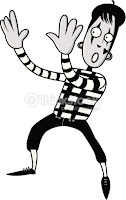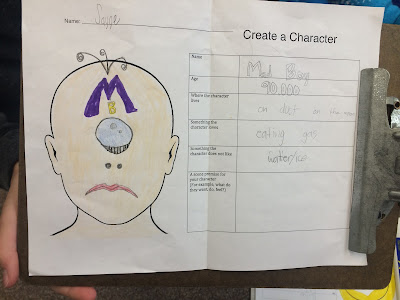 Thursday 1/21: Since the students entered my class excited and ready to finish their drawings and character descriptions of their "create a character" worksheet, I skipped doing a warm-up and allowed them to finish coloring and writing. I think it is important to go with what the students are passionate about and to not rush or hinder their creative process. So I gave them time to complete and show me their drawings. I took a picture of many of their characters, which make up the majority of this blog post!
Thursday 1/21: Since the students entered my class excited and ready to finish their drawings and character descriptions of their "create a character" worksheet, I skipped doing a warm-up and allowed them to finish coloring and writing. I think it is important to go with what the students are passionate about and to not rush or hinder their creative process. So I gave them time to complete and show me their drawings. I took a picture of many of their characters, which make up the majority of this blog post! THEATRE VOCABULARY OF THE DAY: PANTOMIME
 Pantomime is a type of acting where the actor does not use any actual props. Instead, he/she acts like a mime and uses their body (especially their hands) to indicate the props and sometimes even set pieces. This was a familiar concept because many of the students had seen or heard of mimes before (like this picture). There are many Do's and Don't's to telling a story through pantomime, and I focused on 3 of the Do's as part of the vocabulary/training today. This was because the students were not given any props to use for their upcoming scene, and I asked them to pantomime everything instead.
Pantomime is a type of acting where the actor does not use any actual props. Instead, he/she acts like a mime and uses their body (especially their hands) to indicate the props and sometimes even set pieces. This was a familiar concept because many of the students had seen or heard of mimes before (like this picture). There are many Do's and Don't's to telling a story through pantomime, and I focused on 3 of the Do's as part of the vocabulary/training today. This was because the students were not given any props to use for their upcoming scene, and I asked them to pantomime everything instead.1) Express creative details about each pantomimed object: size, weight, smell, texture, temperature, function, and your character's likes/dislikes of the object.
2) Remember where things are and refer to them in the exact same place as where you left/found it. Things cannot just disappear. (I demonstrated this with juggling. You must pick things up and put them back.)
3) Have fun with it and be creative! Use clever devices such as slow motion, making and handling unusually large or small objects, slow motion, ladders, ropes, equipment, and magic tricks. Help us see your world and make it entertaining!
Activity: Talent Contest
Tool: "Create a Character" Sheets and Contestant/Host Sheets
Technique: Pantomime with varying characteristics
Using their "Create a Character" sheets, groups of 4 got together and planned to act as these original characters in the template of a talent contest. First they picked a host and the remaining students in the group (3) were the contestants. Then they picked 3 talents that they would all perform (this is where the pantomime comes in). All of the group members were to perform the exact same talents, with the host demonstrating it at the beginning of each round. The talents are the same to emphasize the difference between characters; different people respond differently to the same things, and have varying levels of skill in the same things. This reiterated that their characters HAD to be different from one another, even though they were performing the same three talents. In their groups, they filled out details on these papers (one for host, 3 for contestants):The roles are on separate sheets of paper so the students can map out their part of the performance. Putting all this information on one sheet and having them share it often makes one student dictate what happens in each part of the scene. Giving everyone their own paper makes them feel more prepared and responsible for their individual part since they each take the time to write it down and can refer to it during the performance. Separate sheets also keeps them more engaged, not waiting for their chance to fill out one thing on a shared piece of paper. YET they still have to all agree upon the talents and the order that they perform, plus the places that they win. (Some groups are going to poll the audience to see who comes in what place.)
THEATRE IN THE ROUND (ARENA)
Since we have spent time talking about the 3 main theatre stages (proscenium, thrust, and arena/theatre in the round), I told the students we would experiment with theatre in the round by placing the audience on either side of the classroom and using the long stretch from the whiteboard to the sink as the stage. In this simple diagram, the dots are the students. Based on the squared shape and the extra furniture in the room, the students ended up sitting in two straight lines rather than semicircles, but this did not hinder them from gaining experience in what arena staging is like; it certainly affects how they actors move (in order to stay open so everyone can see them) and makes the viewing experience more intimate and enjoyable. It was a perfect staging choice for this activity because it made the space feel like a catwalk, which made cheering and high-fiving the performers all the more fun, especially since the performers were so close to the crowd!
SAMPLE TALENTS:
The example talents I gave students where as follows (taken from when I did this activity with another elementary school):
-bake a
pizza or a cake, or cook mac and cheese
-sing a
song
-play an
instrument
-yoyo
-do the
Macarena
-dance
-rap/poetry
-swim
-throw (like an Olympic sport)
-scare
-run in
place
-jumping
jacks
-duck
race
-do a
math test
-fall asleep the fastest and/or snore the loudest
-eat a
ton of food
-juggle pumpkins
-drive a race car
-keep a
straight face while someone is trying to make you laugh
A COLLECTION OF THE COMPLETED "CREATE A CHARACTER" SHEETS FROM BOTH CLASSES:
 |
| Below is a close-up of her drawing. I just love to capture how proud they are of their characters.  |
I really enjoyed seeing all of their drawings. But the fun really began when it was time to act out the talent contest. The host would start off by introducing him/herself and reading his/her answers to questions 1-5 on the worksheet (excluded Question 6, the story premise):
CHARACTER NAME
AGE
WHERE ARE YOU FROM?
WHAT IS SOMETHING THAT YOU LIKE?
WHAT IS SOMETHING THAT YOU DO NOT LIKE?
Then the 3 contestants would answer these same 5 questions.
Then the host would introduce and (often) demonstrate talent 1.
Then talent 2.
Then talent 3.
Then the host would announce 3rd place.
Then 2nd place.
Then 1st place.
During the talent portion, I told the students that each contestant can perform the talent one at a time, or they can make it more of a contest where they ALL do the talent at the same time. Depending on the talent, they would work better being performed together. Singing is better one at a time. Spinning the longest, like in the video below, worked better being performed all at the same time. Enjoy!
Here is a video of a group in Mrs. Ormsby's 5th grade class performing one of their talents: seeing who can spin the longest! Keep in mind that the middle character is a unicorn!
We still have many talent contest scenes to finish, so we will be finishing those and posting more pictures on the next blog! (Out of 14 groups - 7 in each class - we only had time for 3 to present. Many more to come!)




















No comments:
Post a Comment